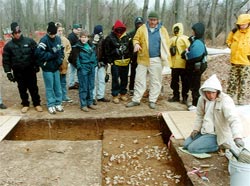Hickory Bluff Project

Come Explore Your Heritage. Dive Into The Past
Issue 3: So, What's With All These Rocks?
Rocks, rocks, rocks - most of what has been found at the Hickory Bluff site consists of rocks. In fact, this isn't unusual for prehistoric Native American sites. Stone is the most common type of material that occurs on archaeological sites in the eastern United States. And for good reason.
Stone was critical to life in prehistoric societies. Few Native American groups had access to metal before Europeans

arrived with iron pots, knives and hoes. Without metal, stone was the material from which many of the most important tools were made. To be sure, other materials like shell, wood, or bone were used, but stone represented the hardest material available for tool making. Sharp, long-lasting cutting edges could be easily produced, and heavy, battering tools could also be made. Stone was also critical to most fire-related activity, like cooking or heating. Rock that has been reddened, cracked or broken by heating often makes up a large proportion of the artifacts from a site. Archaeologists often use the descriptive term fire-cracked rock for these artifacts.
A second reason stone artifacts are so frequently found at archaeological sites is that stone does not decay very quickly. Organic material - wood, bone or shell - decays rapidly when exposed to the elements. But rocks deteriorate very slowly. And so, on many archaeological sites they are the only material that remains.
At the Hickory Bluff site, over 95 percent of the artifacts are stone. Most of this material consists of flaking debris, the waste chips knocked off as stone tools were made or resharpened. Fire-cracked rock makes up the second largest type of artifact, and indicates the importance of fire in the lives of the people inhabiting the site. The remainder of the stone artifacts consist of hammers, knives, projectile points and other tools that were either lost or were broken and discarded.








